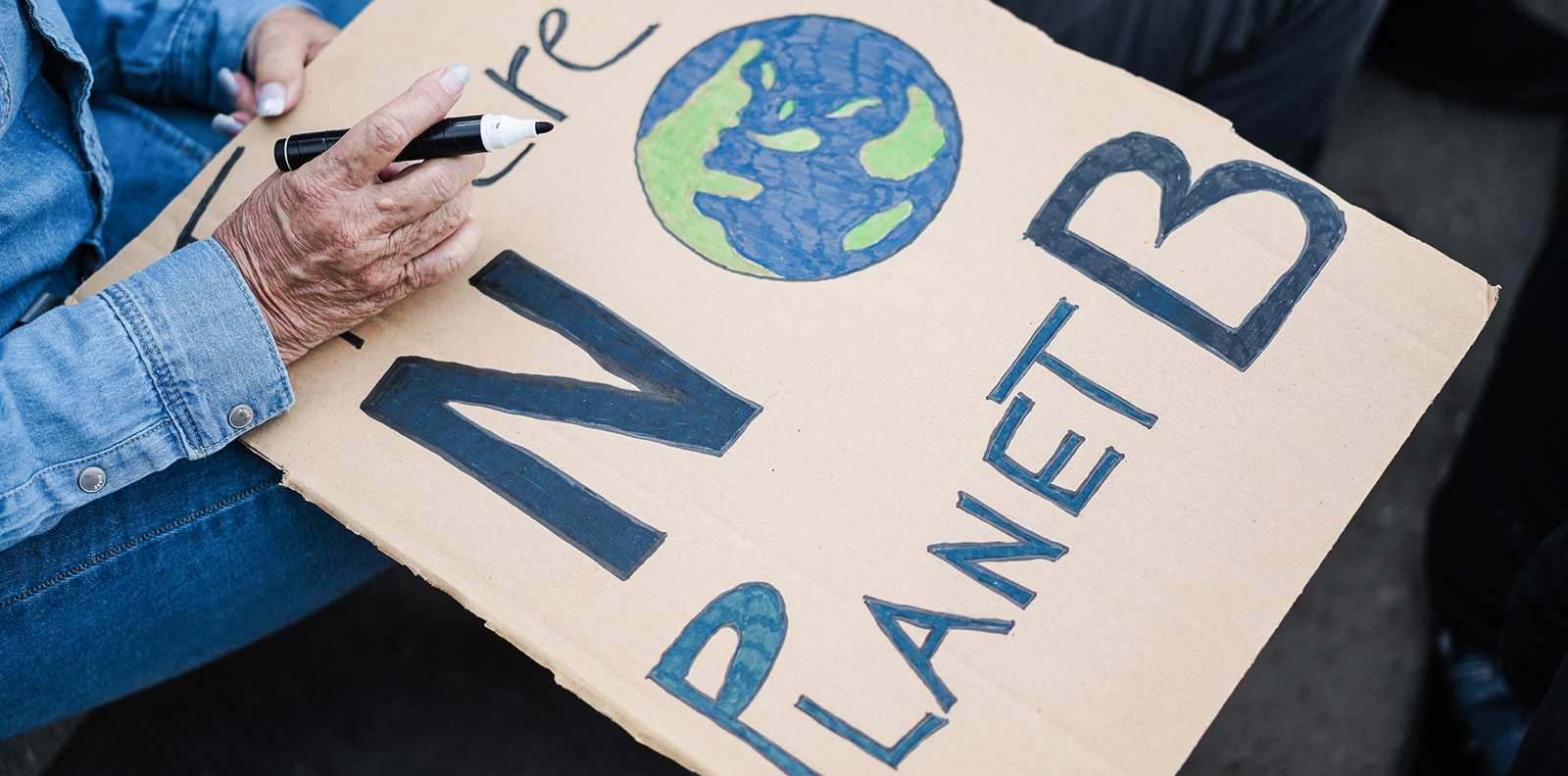Adverse Human Health Outcomes Linked to Climate Change
Environmental professor discusses striking connections between climate crisis and public health
July 3, 2020
The climate crisis isn’t just about polar bears and icebergs melting in faraway places. Envision withering American crops, hungry children, and increasing risk of contagion due to higher temperatures and rising waters. This slightly apocalyptic view is actually happening now in many parts of the world, and local impacts could be equally severe.
As we dive into the dog days of summer in New England, when heat waves, hurricanes, and excessive flooding are brewing, the Metcalf Institute at the University of Rhode Island recently redefined the climate-crisis conversation in a more practical context. Its weeklong series of webinars last month discussed the intersection of the environment, the coronavirus pandemic, systemic racism, and the public-health impacts of climate change.
Kristie Ebi, a professor of environmental, occupational, and global health at the University of Washington in Seattle, was one of the speakers. Her work focuses on understanding the sources of vulnerability, estimating current and projected future risks of climate change, and designing adaptation policies and measures to reduce those risks. She is one of the world’s foremost experts on the climate crisis, examining the ways extreme events impact human health.
Her presentation explained why increasing global temperatures will endanger our health. She noted that little federal funding is dedicated to addressing this very real problem, and that the lack of awareness and prioritization is preventing progress.
“The rate of climate change now is faster than it’s been in more than 10,000 years,” according to a special report by the U.N.’s Intergovernmental Panel on Climate Change (IPCC). The world is already more than 1 degree Celsius warmer than before industrialization, and it’s on track to be about 3 degrees warmer.
“We are in a period of very rapid change in temperature. The projections are that under current emissions, the Earth could warm 1.5 (degrees Celsius) between 2030 and 2052. That is in the very near term,” Ebi said. “Health systems are not prepared to manage this rapid change that we’re undergoing.”
She noted that it’s not just temperatures that are an indicator — it’s the extremes. With a greater increase in intense heat across the globe, there is more frequent and intense weather, including additional precipitation, which exacerbates flooding, especially during high tides, and sea-level rise.
With a 1 degree increase in temperature, there could be as much as 4 percent more water vapor in the atmosphere. Parts of the Midwest didn’t dry out for months last year, Ebi said. Crops were destroyed, and farmers were unable to plant. The situation, which led to devastating impacts on livelihoods and food insecurity, caused mental-health issues, she said.
According to the Centers for Disease Control and Prevention (CDC), the climate crisis is creating a domino effect. Rising temperatures and water levels increase air pollution and allergens, leading to more respiratory issues; diminish water quality; impact the global food supply; intensify public-health issues such as malnutrition and cholera; and increase heat-related illnesses, such as tick-borne diseases like Lyme, and death.
Extreme weather also impacts the atmospheric levels of carbon dioxide, which leads to more environmental degradation. All this stress can cause civil conflict and create climate refugees.
“It’s a cross-cutting issue, and a stress multiplier,” Ebi said. “It increases challenges across a whole range of systems and health outcomes. But this is a reminder that it’s not just our health that’s being affected by climate change — it’s also our health-care infrastructure.”
The heat is on
The Fourth National Climate Assessment reported that exposure and resilience vary across populations and communities. For example, children and older adults are at greater risk of heat stroke and of being impacted by extreme weather events that cause power outages and require evacuation.
Communities of color and low-income neighborhoods are more vulnerable, because they live in risk-prone areas facing cumulative exposure to multiple pollutants or face greater threats of illness during flooding.
Comprehensive disaster management can improve the situation for people with limited resources, and adaptation plans that consider these communities and improved access to health care can help address these social inequities, according to Ebi.
“Adaptation reduces risk, and it improves our health,” Ebi said. “There is a lot that can be done in the short and long term to increase overall resilience to a changing climate.”
The Chicago heat wave of 1995 caused 600 excess deaths during that time period, while in 2003, there were a few heat waves in Europe that caused more than 70,000 excess deaths, she said.
“These have significant consequences. Our body physiologically can’t handle high temperatures,” she said. “Heat-related deaths are preventable.”
Undernutrition is another often-ignored facet of the climate crisis. Food insecurity is on the rise, and the Food and Agriculture Organization of the United Nations has reported that a changing climate and rising carbon dioxide emissions are a culprit, because higher temperatures mean lower or insufficient yield in places that already struggle to provide enough food.
In temperate regions, wheat yields change little with warmer weather. But in the tropics, where most cereal crops are growing at the thermal edge of their tolerance, any increase in average temperature leads to a decrease in crop yield. Also, as plants adapt to this new normal, their physiology changes, impacting their nutritional content. Worldwide, 75 percent of calories come from cereal crops such as rice, wheat, barley, and maize.
If those crops produce lower yields and have a lower nutritional value, it will lead to as many as 830 million more people who are food insecure, Ebi said.
“There are two billion people who have micronutrient deficiencies. Iron deficiencies like anemia affect women and children throughout the world,” she said. “Experiments suggest that iron, zinc, and other micronutrients that are important for our health decline five to ten percent [when carbon dioxide increases], so this could have a significant consequence for children’s health.”
Temperatures and precipitation also impact the activity and life cycle of mosquitoes and ticks. Under high emissions there are large swings in their geographic range, which distributes the diseases they carry, such as Lyme, West Nile virus, and the lesser known chikungunya virus, further, which will have profound implications for the Northeast.
“As temperatures get warmer, as people travel more, as we have more commerce across states and countries, we’re seeing the introduction of mosquitoes and viruses,” Ebi said. “And we are expecting to have more outbreaks of infectious diseases, unless actions are taken.”
From all the health risks associated with a changing climate, there are mitigations that can reduce these threats. Ebi said the global community needs to take significant action, from how it thinks about the structure of institutions, to infrastructure, to how we work, to how we manage the growing number of people being impacted by the climate crisis.
Reducing carbon emissions is where to start. In the United States, that means addressing the transportation sector by using public transportation, flying less, driving electric vehicles, and walking and biking more.
“I’ve heard far too many statements from high-level people that climate change is an environmental issue, and therefore somebody else should handle it,” Ebi said. “We could reduce our health-care costs, people could have healthier lives. We should be mitigating for our health.”
Categories
Join the Discussion
View CommentsRecent Comments
Leave a Reply
Your support keeps our reporters on the environmental beat.
Reader support is at the core of our nonprofit news model. Together, we can keep the environment in the headlines.
We use cookies to improve your experience and deliver personalized content. View Cookie Settings




I thought this would also make the point that connects both the climate emissions from and the resulting poor heath of the many many who drive everywhere and rarely walk, bike, or exercise, (and of course we accommodate them by building the roads, the parking lots, removing the snow from only the roads, guarding the oil supplies….)